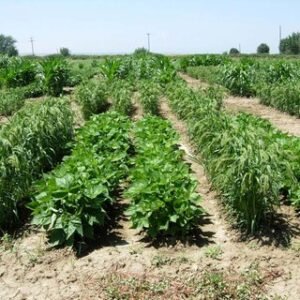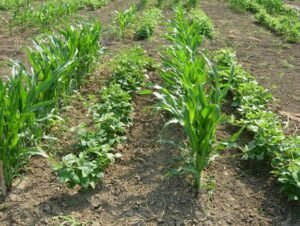How to do Intercropping in Organic Farming?
Organic Agriculture has gained immense popularity in recent years because of its high nutrient content which makes the plant more healthy and effective. Organic Agriculture practices organic methods of farming which are performed after effective planning and management techniques.
A crop is well grown when it is performed with well equipped methods of farming and also it requires proper planning on the first hand for which you need to collect all the information about your crops and its requirements. The Farmers are required to contact the experts or trained farmers who have already performed organic farming for better knowledge about the cultivation of their crops. After planning the crops, the farmers are also required to manage them because without management, the planning can go to waste.

Organic farming majorly uses three methods of planning and management for the crops which are Crop Rotation, Intercropping and Cover Crops. Here in this article, we are going to discuss Intercropping and its implementation in Organic farming.
What is Intercropping?
Intercropping is a farming method in which more than one kind of crop is grown on the same piece of land at the same time. One of the most basic reasons to plant more than one kind of crop is to produce even a greater yield that would maximize the profit margin of the farmers who employ this kind of farming method. Small farmers who are not financially sound, do not have the technological capacity or enough farmland to have a larger yield. Intercropping is found to be one of the most productive methods in which farmers can have a greater yield within their confined space and limited resources.
Types of Intercropping Methods:
There are various types of intercropping methods implemented by farmers all over the world. Below are those methods given in detail.
- Mixed Intercropping
Mixed cropping is a method of growing two or more crops grown simultaneously in the same piece of land. There is no specific pattern; seeds are sown without any distinct pattern. The same kind of fertilizer is also applied for the diverse range of crops that are planted. It requires less effort than any other intercropping methods and its goal is to minimize the risk of crop failure unlike other intercropping methods whose goal is the increase in the profit margin of the farmers.

- Patch Intercropping
Patch intercropping refers to the growing up of two or more than two different kinds of crops together in a field in the form of patches.
- Strip Intercropping
Strip intercropping is an agricultural practice of cultivating two or more crops in the same field. In this type of intercropping method, the fields are divided into strips. For example, a popular pattern of strip intercropping is growing wheat, corn and soybeans etc.
- Relay Intercropping
Relay intercropping is a particular kind of cropping pattern in which the lifecycle of one crop overlaps the lifecycle of another. It is mainly done in the regions where the growing season is too short for the growth of two discrete crops. Relay intercropping reduces temporal overlap in harvesting different species. Examples of relay intercropping are cotton and corn or chickpea and upland rice.
- Parallel Intercropping
In this type of intercropping, we grow two or more particular crops which have different growth habits so that there is no competition among them.
- Alley Intercropping
Foods are grown in the alleys formed by hedges, shrubs or trees. It is a part of agroforestry system.
- Traps Intercropping
This intercropping technique is used to trap pests in order to protect the main crops. Popular examples of trapping plants are mustard and marigold among others. Trap cropping helps to save on pesticides with no chemical application at all. However, its possible disadvantages are developing resistance to insecticides or uncontrolled pest nurseries.

- Row Intercropping
In row cropping, plants are arranged in rows. A common beneficial combination is cereals with legumes like cotton and beans.
- Temporal Intercropping
In this method, the combination of plants requires different maturing periods. When a fast-growing plant is cultivated with the slow-growing one, the slow-growing one has more space to develop as the fast growing plant would be harvested before the latter.
- Guard Cropping
Guard crops are thorny or hardy plants which are grown by the farmers around the main cash crops. The main purpose of this type of intercropping is to protect the main species from wind and pest invasions. Example : Sorghum is grown around cotton, safflower around chickpea etc.
- Repellent Intercropping
In this intercropping method, farmers use the pest-repellent plants to prevent the insects from destroying the main cash crops. For example, planting leeks to protect beans from bean flies.
- Push-pull Cropping
This intercropping technique combines both the trap and repellent plants for the sake of the cash crops. While trap species attract pests, repellent ones push them away. For example, growing Napier grass (to pull) and Desmodium legume (to push) in order to save the corn from stem boring corn larvae.
How to do Intercropping in organic farms?
Though there may be several advantages of intercropping in organic farming, they come at a cost of much more complicated additional management. In order to do intercropping it requires a precise and careful timing of field operations and may also require regular observations of the field in order to keep a check on the competition for sunlight, nutrients and space between the intercropped species.
A careful plan for intercropping should be laid out beforehand because a crop combination that works well in one particular year might fail and not work well in the consecutive year due to the change in weather patterns. Therefore, a proper and appropriate combination of crops must be used.

For an intercropping scheme to succeed, one should improve the overall economics of the farm. An intercropping idea should be first tested in a small field, then the results should be evaluated carefully. If the benefits of the intercropping idea outweighs the extra cost, labor or yield reduction then the plan for the intercropping should be implemented otherwise it is unwise to go ahead with the intercropping technique.
When two or more plants are combined in a field together, plant densities need to be adapted in an appropriate manner in the intercropping method. If more than required plants are cultivated, then neither of them would have an adequate yield because of the overcrowding of plants.
Planting and maturity dates should be kept in mind while planning for intercropping. It is an advantage if the crops that are being cultivated have different planting and maturity dates. With different times of peak demand and nutrition there would be less competition for sunlight, water and nutrients.
During the implementation of the intercropping system, it is crucial to pay attention to the plant architecture (height and width). Different crops may have a different kind of plant architecture.
Appropriate spatial arrangement of the crops should be there in accordance to the field in which they are cultivated. For example: row intercropping, mixed intercropping, relay intercropping, strip intercropping etc.
Recommendations for successful Intercropping
Below are mentioned some useful recommendations for intercropping.
- The crops for intercropping should be selected with utmost care as every crop has different growing habits, duration, root growth, taxonomy, etc. Therefore, we need to ensure certain requirements and precautions, which are stated below:
- The peak period and the nutrient demands of the crops should not overlap.
- The differences in maturity of the component crops should be at least 30 days.
- Bushy crops should be grown along with tall growing crops.
- The crops that are selected should belong to different families so as to avoid pests and diseases.
- Slow growing crops should be planted in vacant spaces of fast growing crops.
- Shallow rooted crops should be used with deep rooted crops.
- The component crops should show a negligible allelopathic effect.
Advantages of Intercropping in agriculture

- Farmers, especially the ones who cannot afford a large capital investment, this method of farming proves to be a blessing in disguise for them as they can maximize their output within their limited field.
- This method of farming helps the farmers to suppress the weeds since the crops take up much more space, leaving aside negligible space for the growth of the weeds.
- Growing two crops alongside each other can be of a great benefit as their interactions would increase the stability of one or both the plants. For example, the plants that are likely to tip over the winds may gain structural support from their companions.
- Crop diversity has proved to be incredibly beneficial in terms of reduction of pests. Trap cropping involves planting a crop that is more attractive to pests than the regular production crops.
Disadvantages of Intercropping in agriculture
- Harvesting the crops that are grown through intercropping is generally much more difficult than the conventional methods.
- There is a high chance that there would be competition among the crops for sunlight, nutrients and space to grow.
- Large farms with adequate resources may likely receive less benefit out of intercropping.
- Labor costs are more likely to increase when the farming methods involve intercropping.
Conclusion
Intercropping could be an extremely beneficial technique in the organic farming industry. Weed control can be a major source of concern for the organic farmers but with the help of intercropping we could overcome this major hurdle. It can gradually increase the total output for the farmers, thus increasing their profit margin, but it is a complex procedure therefore it must be implemented properly with utmost caution.




